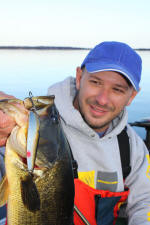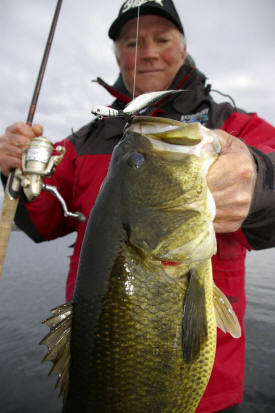|
 Bucktail
Jigs for Cold Weather Green-Backed Bass Bucktail
Jigs for Cold Weather Green-Backed Bass
By
Justin Hoffman
Toss some fur when the water cools for fantastic fall time bassin’….
As the month of ghosts and goblins descends upon us, determining
what trick or treat to toss for scary-sized bass becomes definite
food for thought.
Cooling water and shorter days signifies a change in largemouth bass
behaviour. The once fertile and active shallows show less signs of
life, as fish begin staging in deeper water, content to put on the
feed bag for the long, arduous winter that lies ahead. Capitalizing
on this movement – and the aggressive binge – can lead to fruitful
days on the water. The diminutive bucktail jig is a trick that is
sure to bring bountiful fall treats.
The Jig is Up
Bucktail jigs have an uncanny knack for replicating the movement and
action of baitfish. Whether it is a shad, perch, or shiner, the
undulating fur and flash of a streaking and fluttering jig mimics
this prey perfectly.
Largemouth bass can be quite lethargic when the water cools. Chasing
down fast moving baits becomes more of a chore, and many fish prefer
to take the “sit and wait” approach when snack time is concerned.
The dynamics of a jig is what shines. Tossing a vertical
presentation equates to more time in the strike zone. It also means
less of a chase factor for bass, which generally gives an angler
many more bites throughout the course of a day. And although they
may be docile in nature, largies can be downright mean when they
slam a jig that happens to flutter seductively in their face.
 Another
concept that works well with bucktail jigs is their snack-sized
appearance. They are exceptionally easy for a bass to suck in (being
only fur, light hook and a jig head) which means added strikes when
compared to some of the more conventional styles of bait that are
thrown come fall. Another
concept that works well with bucktail jigs is their snack-sized
appearance. They are exceptionally easy for a bass to suck in (being
only fur, light hook and a jig head) which means added strikes when
compared to some of the more conventional styles of bait that are
thrown come fall.
Where To Go
Good friend and fellow outdoor writer Tim Allard and I
stumbled upon our bucktail jig tactic a few years back. It was late
October and we were plying the abundant weed clumps for walleye on
our favourite Eastern Ontario lake. Working the edge of green
vegetation and amongst the inner clumps, we began trouncing the
largemouth bass with almost every cast. Fish were holding within the
thick weeds and eagerly hitting our jigs as we worked them in a rip
and flutter technique. The spot coughed up a few walleye, but it was
the largemouth bass that has kept us returning each fall ever since.
(The 30 or 40 fish we routinely swing in the boat is also a definite
draw!)
Finding healthy weeds is paramount for success. The more green the
better. A mixture of different types – cabbage and thick coontail is
an exceptional combination – will often lead to an increase in fish
concentration.
In terms of depth, my best luck has happened in water between 7- and
10-feet deep. A tip is to head out from shore until you intercept
the outside weed edge, and then work adjacent to it, while working
inwards also. Getting them right on the edge – or within the thicker
stuff – will usually depend on weather conditions. The more
inclement the better the chances they will be positioned on the
outside edge.
 Tactics
and Equipment Tactics
and Equipment
Working a bucktail jig is fairly simple. Start with short
underhand pitches or casts. As your jig settles amongst the weeds on
a fairly slack line, a sharp snap of the rod will quickly bring it
upwards. How high you snap your jig up will often depend on the
vegetation you are fishing – or the activity level of the fish – but
a common rule of thumb is one to two-feet. Then simply repeat the
process.
Most largemouth will grab a jig on the fall, registering as a
“thump” or a dead weight at the end of the line. Set the hook hard
on these fish. It is also common to have a fish tackle your jig as
it breaks free of the weeds on a snap. In this case, the hook has
already been driven home.
In terms of equipment, my preference lies with a 6’10” medium-heavy
spinning rod. A rod of this type possesses the necessary backbone
for ripping jigs and also ensures healthy hooksets. Couple this up
with a high-quality braid in 30lb test strength. I forgo a fluoro
leader with this set up as line visibility does not come in to play.
Braid will also cut through weeds optimally, giving it a definite
nod over both mono and fluoro.
Choosing a jig is fairly simple. Pick a weight that is light enough
for optimum action and flutter speed but still enables you to feel
its action. A mainstay on my rod is ¼ oz. If you are faced with wind
and waves, upsize to a 3/8 or 1/2oz. Skinny water dictates a lighter
jig.
I stick to a few select colours, including black, grey, white, blue,
red, and yellow. Two-tone often gets the nod in any of these proven
hues (with white or black being the base colour) and a bit of tinsel
for flash can often attract a few extra fish.
Tipping your jigs is not necessary. Minnows and worms are easily
ripped off when working the weeds and also alters the simplistic and
streamlined approach that this technique is based on.
Give bucktail jigs a try for largies this fall. Be forewarned,
though – you’re bound to have a hauntingly good time!
Check out Justin’s Website/Blog at:
www.justinhoffmanoutdoors.com
Editors & Publishers
T.J. & Monique Quesnel
|
The
Ontario Fishing Network
E-Magazine is
published 12 times a year on or near the beginning of every month. Our
magazine is geared to any angler who enjoys fishing of any type in the
wonderfully diverse province of Ontario. Editorial Submissions: We welcome query letters,
but assume no responsibility for unsolicited materials. Subscriptions: Subscriptions are FREE of charge
and delivered via email.
You can subscribe
HERE: Privacy Policy: Unlike other publications We
NEVER make our subscribers list (your email address) available to any
other companies. Advertising: If you are interested in advertising
please email us. Circulation - 13,000 email subscribers
© 2011 Due North
Marketing / Ontario Fishing Network / T.J. Quesnel. All rights
reserved. Reproduction of any material without prior written
permission strictly prohibited. |
|